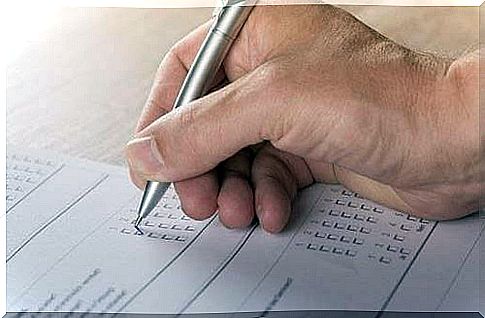Rosenberg’s Scale For Measuring Self-esteem

One of the most well-known and well-accepted self-assessment tests is without a doubt Rosenberg’s scale. The test has actually been used for more than five decades and it is its simplicity (it consists of only 10 questions) and reliability that has helped it maintain its popularity over the years.
When we talk about self-esteem, it is clear that most people have a sense of humor about what it means. In principle, it is the perception you have about yourself and how you judge yourself. It is worth noting that self-esteem also has three more complex aspects that form a psychological canvas filled with unique shades of color, shapes and perspectives.
Self-esteem is linked to the thoughts you have about yourself every day. It’s also about your perception of how other people see you. Other things that come into play are e.g. your upbringing, your education, your relationship with your parents, your friends and your partner. Self-esteem includes i.a. such concepts as identity, self-awareness and self-efficacy.
If you want to dig deeper into the concept of self-esteem, you are wise to start with the work done by Morris Rosenberg at the University of Maryland. Rosenberg is a professor of sociology and a pioneer in his field. It was in one of his books, Society and Adolescent Self Image (1965), that he first shared his self-esteem scale.

Rosenberg’s scale for measuring self-esteem
Self-esteem is a subjective psychological construct. We know that our experiences, how we evaluate these experiences, how we talk to ourselves, how we treat ourselves, how we value ourselves in almost all aspects of life are the building blocks of self-esteem.
At the same time, it is important to remember that self-esteem is an emotional concept. It can fluctuate at any time, depending on how you interpret and handle different events in your life. In other words, no one is born with high self-esteem and then maintains this for life.
For self-esteem is like a muscle. And if you neglect it, it can be weakened. But if you practice it every day, everything will flow and feel a little easier and you will have enough energy to deal with everything. Therefore, it is good to use Rosenberg’s scale for measuring self-esteem as a starting point to find out in what condition this “psychological muscle” is.
The background to Rosenberg’s scale
Morris Rosenberg developed the scale based on data from 5,024 young people in American schools. His idea was to try to understand how people’s social context affects their self-esteem. He knew that such factors as education, environment and family could potentially affect the above-mentioned psychological construct.
His intention was to develop a self-assessment test to make an assessment of how young people in the United States were doing. He conducted the study in 1960 and in scientific circles it immediately aroused interest, as the scale proved to be very reliable. And even today it is still just as relevant.
How to perform Rosenberg’s self-assessment test
What is remarkable about this test is how easy it is to perform. The test consists of ten statements that the informant preserves according to a Likert scale, which ranges from “fully agree” to “strongly disagree”. If you are wondering how such a short test can be so effective, consider the following:
Dr. Richard W. Robbins claimed in 2001 that a question, such as: “Do I have good self-esteem?”, Was enough to be able to evaluate a person’s self-esteem. In fact, Dr. Robbins created a special scale, the “Single-Item Self-Esteem Scale” (SISE), and conducted a study that showed that it was as effective as Rosenberg’s scale.

Rosenberg’s self-assessment scale and how it is evaluated
Rosenberg’s test contains the following points:
- I think I am a valuable person, at least as valuable as others.
- I think I have several good qualities.
- On the whole, I tend to see myself as a failure.
- I can do things as well as most people.
- I do not think I have much to be proud of.
- I have a positive attitude towards myself.
- Overall, I am happy with myself.
- I wish I had more respect for myself.
- Clearly, I feel worthless sometimes.
- Sometimes I think I’m not good at anything.
The respondent answers each question with one of the following options:
- A. Fully agrees
- B. Agree
- C. Disagree
- D. Do not agree at all
The interpretation of the test results
The method for evaluating each answer is as follows:
- Questions 1-5: A is worth 4 points, B is worth 3 points, C is worth 2 points and D is worth 1 point.
- Questions 6-10: A is worth 1 point, B is worth 2 points, C is worth 3 points and D is worth 4 points.
This means that if you achieve 30 to 40 points, then you have good self-esteem. If you achieve between 26 and 29 points, then you need to improve your self-esteem. And if your score is 25 or lower, then you have low self-esteem.
In summary, it can be said that Rosenberg’s scale is a useful and simple tool for measuring self-esteem both in clinical contexts and among the general population. In other words, the test is still a relevant psychological tool.









